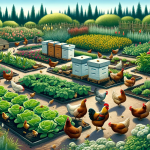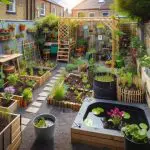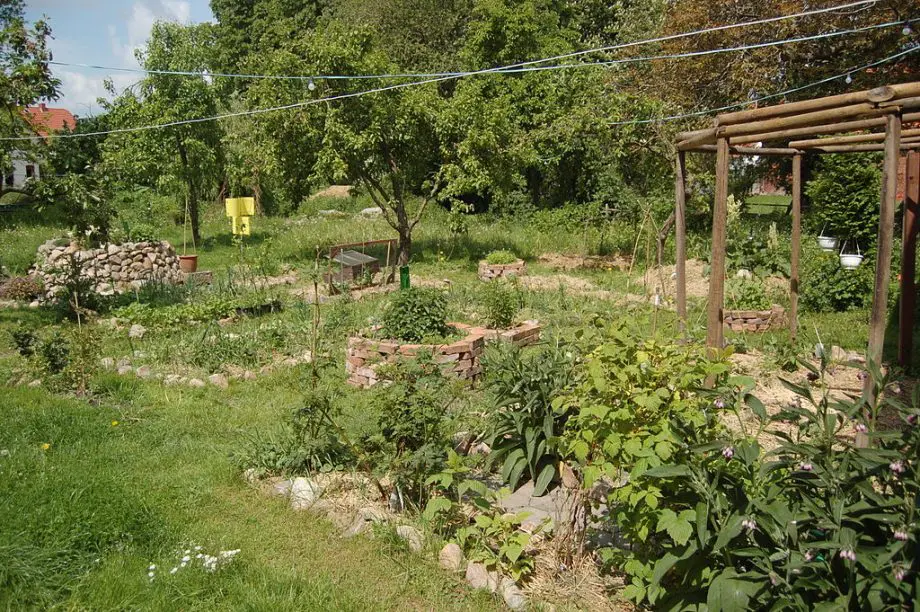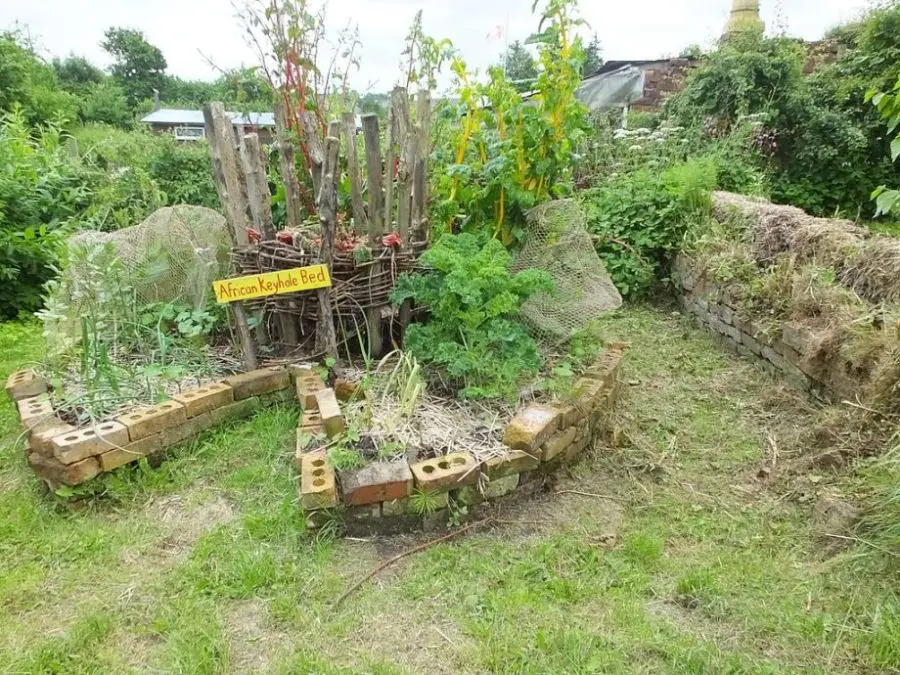
Discover the wonders of a permaculture keyhole garden! Learn how this sustainable, space-saving garden design can transform your gardening experience.
Keyhole Gardens Key Takeaways:
- Permaculture keyhole gardens are innovative, circular garden beds designed for efficient space use and water conservation.
- Central to their design is a composting basket, which nourishes the surrounding soil, making them ideal for small spaces and sustainable gardening.
Welcome to the world of permaculture keyhole gardens! A unique blend of sustainability and practicality.
These gardens are not just a space to grow food; they’re a journey into efficient, eco-friendly gardening.
Join us as we explore how to create and nurture your very own permaculture keyhole garden.
Permaculture Keyhole Gardens
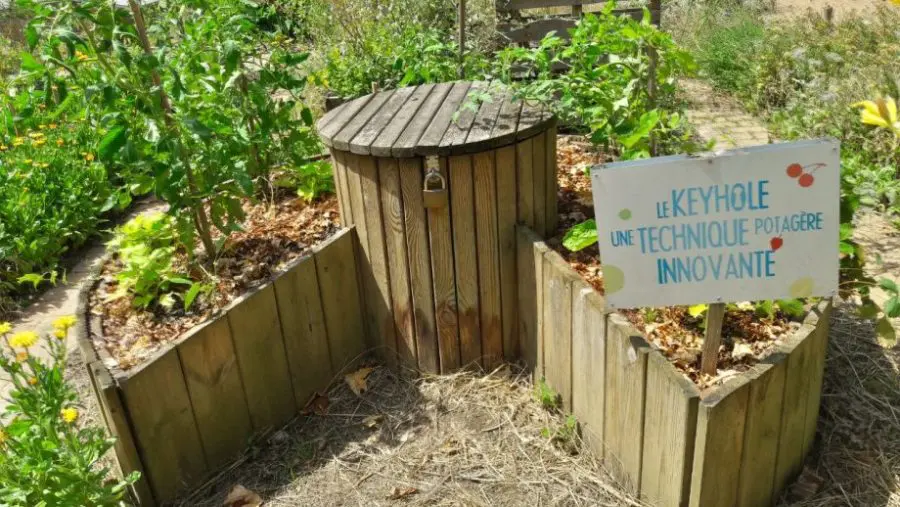
Permaculture keyhole gardens are a marvel in sustainable gardening, offering a unique blend of efficiency and productivity.
Originating from the heart of Africa, these gardens have gained global acclaim for their ability to turn small spaces into thriving sources of food.
This article delves into the world of keyhole gardening, a method that combines traditional wisdom with modern ecological practices, making it a great way to grow your own food, especially in areas with poor soil or dry climates.
Definition and Origin
Keyhole beds, a central concept in permaculture keyhole gardens, were first developed in Africa.
These gardens are named for their distinctive shape, resembling a keyhole when viewed from above.
This design was a response to challenges like soil erosion and water scarcity, offering a sustainable solution for food security in harsh environments.
Keyhole Garden Concept
Keyhole garden beds are circular raised beds with a “keyhole”-shaped cutout for easy access.
This ingenious design allows gardeners to reach the entire growing area without stepping into the bed, ensuring minimal soil compaction and easy maintenance.
Benefits of Sustainable Living
Keyhole gardening is a cornerstone of home-scale permaculture, promoting sustainable agriculture by maximizing space and resources.
These gardens are particularly effective in small areas, making them ideal for urban settings or homes with limited yard space.
They also contribute significantly to soil fertility and water conservation, crucial in combating climate change and promoting eco-friendly gardening practices.
Keyhole Gardens Explained
A keyhole garden is a two-meter-wide circular raised garden with a keyhole-shaped indentation on one side. The indentation allows gardeners to add uncooked vegetable scraps, greywater, and manure into a composting basket that sits in the center of the bed. In this way, composting materials can be added to the basket throughout the growing season to provide nutrients for the plants.
The upper layer of soil is hilled up against the center basket, so the soil slopes gently down from the center to the sides. Most keyhole gardens rise about one meter above the ground and have walls made of stone. The stone wall not only gives the garden its form, but helps trap moisture within the bed.
Keyhole gardens originated in Lesotho and are well adapted to dry arid lands and deserts. In Africa, they are positioned close to the kitchen and used to raise leafy greens such as lettuce, kale, and spinach; herbs; and root crops such as onions, garlic, carrots, and beets.
Keyhole gardens are ideal for intensive planting, a technique in which plants are placed close together to maximize production. Plants with wide-reaching root systems, such as tomatoes and zucchini, may not perform well in a keyhole garden. Wikipedia
Design and Construction of Keyhole Gardens
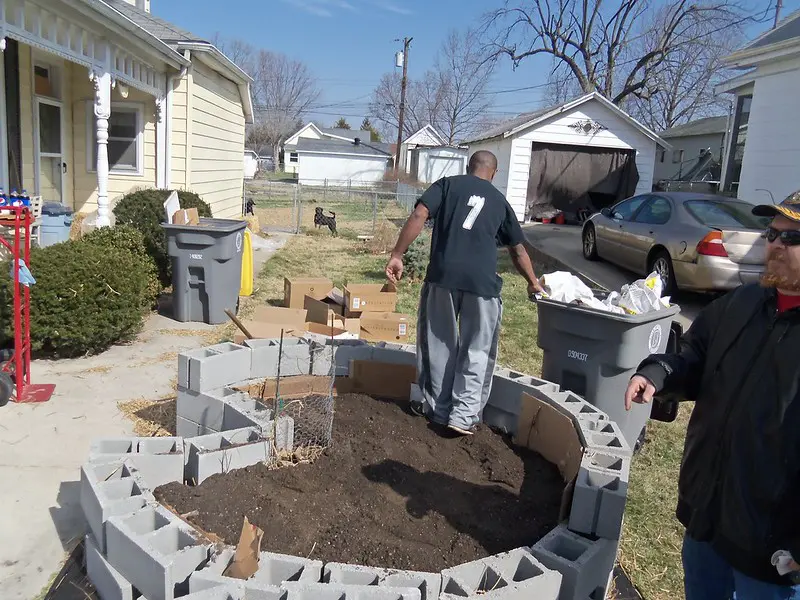
Designing and constructing a keyhole garden is a journey into creative and sustainable garden design.
This section explores how to build these innovative beds, turning a small area into a productive garden.
Whether using natural materials or repurposed items, keyhole gardens are adaptable to various settings, embodying the principles of permaculture design.
Basic Structure and Shape
The keyhole garden’s unique shape is not just for aesthetic appeal; it serves a practical purpose.
The circular design, with a notch for easy access, creates a space-saving garden layout.
This shape maximizes the growing area while ensuring every part of the bed is within arm’s reach, making it a functional focal point in any garden.
Materials for Construction
You can construct keyhole garden beds from different materials, including stones, concrete blocks, wood planks, or recycled items like glass bottles.
The choice of material often depends on availability and personal preference.
It’s essential to ensure that the materials provide adequate structural support to hold the soil and organic materials.
Steps in Building a Keyhole Garden
- Selecting the Location: Choose a spot in full sun, ideally close to a water source. The area should be flat and have good drainage.
- Laying the Foundation: Start by marking the desired shape on the ground. A typical keyhole garden is about 6 feet in diameter.
- Building the Walls: Construct the walls using your chosen materials. The walls should be sturdy enough to hold the soil and organic matter.
- Creating the Compost Basket: In the center of the garden, build a compost basket using chicken wire or similar material. This basket will hold kitchen scraps and garden waste, turning them into valuable compost.
- Filling the Garden: Layer organic materials, starting with coarse materials like branches at the bottom, followed by layers of compostable materials, grass clippings, and topsoil.
Size and Location Considerations
The size of a keyhole garden can vary, but it’s typically not larger than 6 feet in diameter to maintain easy access to all areas.
The location should be chosen based on sunlight exposure, proximity to kitchen waste (for easy composting), and ease of watering, possibly using greywater systems for sustainability.
The Role of Composting in Keyhole Gardens
Composting is the heart of keyhole gardening, transforming kitchen scraps and yard clippings into a rich, nourishing resource for plants.
This section highlights the importance of composting in these gardens, illustrating how it enhances soil fertility and supports sustainable food production, even in challenging environments like dry climates or areas with poor soil.
Composting Process
The composting process in keyhole gardens is a simple yet effective way to recycle organic waste.
Kitchen waste, grass clippings, and other compostable materials are layered in the central composting basket.
Over time, these materials break down, creating compost tea that enriches the surrounding soil, feeding the plants.
Importance of Organic Matter
Organic materials are crucial in keyhole gardens. They improve soil structure, increase water retention, and provide essential nutrients.
The compost pile acts as a continuous source of organic matter, ensuring that the soil remains fertile and productive throughout the growing season.
Maintaining the Compost Cage
The compost basket, typically made of chicken wire for aeration, is central to the garden’s design.
Regularly adding kitchen scraps and garden waste to the basket is vital.
It’s also important to maintain a balance of green (nitrogen-rich) and brown (carbon-rich) materials for effective composting.
The compost should be moist but not soggy, and occasional turning can help speed up the decomposition process.
Planting and Crop Selection
Choosing the right plants for your keyhole garden is a key step in ensuring a bountiful harvest.
This section explores the variety of plants that thrive in these gardens, from leafy greens to robust vegetables.
We’ll also discuss how to strategically place plants for optimal growth, making the most of the nutrient-rich soil and unique design of keyhole beds.
Suitable Plants for Keyhole Gardens
Keyhole gardens are versatile and can support a wide variety of plants.
Vegetables like tomatoes, carrots, and leafy greens, along with herbs such as basil and parsley, are excellent choices.
The garden’s design is particularly beneficial for plants that require rich, compost-heavy soil.
In areas with extreme heat, plants that can withstand such conditions, like okra or peppers, are ideal.
Planting Techniques
The circular design of keyhole gardens allows for efficient use of space.
Plant tall plants, like tomatoes or fava beans, near the center to avoid shading smaller plants.
Utilize the edges for shorter or sprawling plants, like strawberries or herbs. This approach ensures all plants receive adequate sunlight and nutrients.
Crop Rotation and Diversity
Rotating crops each growing season is a good idea to maintain soil health and prevent disease.
Keyhole gardens, with their rich, compost-fed soil, are perfect for practicing crop rotation.
Additionally, incorporating a variety of plants, including companion planting, can enhance the garden’s health and productivity.
This diversity not only benefits the plants but also encourages beneficial insects and improves overall garden ecology.
Watering and Nutrient Management
Efficient watering and nutrient management are pivotal in keyhole gardening, especially in dry climates or areas prone to soil erosion.
This section delves into the strategies for ensuring your garden remains hydrated and nutrient-rich, utilizing techniques like greywater systems and compost tea, to foster a thriving garden with minimal water waste.
Efficient Watering Techniques
Keyhole gardens are designed for water efficiency. Watering directly into the compost basket allows water to seep through, carrying nutrients to the surrounding soil.
This method minimizes water usage while ensuring plants receive both moisture and nutrients.
For gardens in full sun, using greywater can be a sustainable watering solution, reducing the need for fresh water.
Nutrient Distribution
The central compost pile in a keyhole garden is a natural nutrient distributor.
As kitchen waste and garden clippings decompose, they release nutrients that permeate the surrounding soil.
This process creates a self-fertilizing system, where plants receive a steady supply of essential nutrients, promoting robust growth throughout the growing season.
Greywater Usage
Incorporating greywater systems into keyhole gardening is a sustainable practice, especially in areas with limited water resources.
Greywater from household sources like sinks or showers can be redirected to the garden, providing a regular water supply.
This not only conserves water but also makes good use of resources that would otherwise go to waste.
Maintenance and Seasonal Care
Maintaining a keyhole garden is a rewarding process that ensures its productivity and longevity.
This section covers essential maintenance tips and seasonal care strategies.
From the simplest form of upkeep to preparing for different seasons, these practices help your garden adapt and thrive, ensuring a continuous supply of fresh, home-grown food.
Regular Maintenance Tips
Regular maintenance of a keyhole garden involves monitoring the compost pile, ensuring it remains active and well-balanced.
Adding layers of straw or grass clippings regularly can help maintain the compost’s health.
It’s also important to check the structural integrity of the garden, repairing any large holes or weak spots in the walls or compost basket.
Seasonal Adjustments
Adapting your keyhole garden to different seasons is crucial for its success. In the growing season, focus on planting, watering, and feeding your plants.
As seasons change, especially in extreme heat or cold, adjust your planting choices and care routines accordingly.
For instance, during hot summers, mulching can help retain soil moisture, while in colder months, covering your garden with a layer of compost or mulch can protect it from frost.
Long-term Sustainability
To ensure the long-term sustainability of your keyhole garden, it’s important to practice crop rotation and diversify the types of plants grown.
This not only prevents soil depletion but also discourages pests and diseases.
Additionally, refreshing the compost basket with new organic materials and occasionally cleaning it out helps maintain soil fertility and garden health.
FAQs on Permaculture Keyhole Gardens
Keyhole gardens, with their unique design and sustainable approach, often spark curiosity and questions.
In this FAQs section, we address some common inquiries about keyhole gardening.
From basic how-tos to more specific queries, these answers aim to provide clarity and inspire confidence in both novice and experienced gardeners interested in this efficient and eco-friendly gardening method.
Q. What is the ideal location for a keyhole garden?
A. The ideal location for a keyhole garden is a spot that receives full sun for most of the day.
It should be on level ground and preferably close to a water source.
If you plan to use kitchen scraps in your compost pile, placing the garden near your kitchen can provide easy access.
Q. Can keyhole gardens be used in arid climates?
A. Absolutely! Keyhole gardens are particularly well-suited for arid climates due to their efficient use of water.
The central compost basket helps retain moisture and distribute it evenly throughout the garden.
Using greywater systems can further enhance their suitability in dry areas.
Q. What are the best crops to grow in a keyhole garden?
A. Keyhole gardens are versatile and can support a wide range of crops.
Vegetables like tomatoes, carrots, and leafy greens thrive in these gardens.
Herbs and smaller fruit-bearing plants like strawberries also do well.
The key is to choose plants that suit your local climate and soil conditions.
Q. How does a keyhole garden contribute to sustainable living?
A. Keyhole gardens contribute to sustainable living by maximizing the use of small spaces, reducing water usage, and recycling organic waste into compost.
This type of garden bed minimizes the need for external inputs like chemical fertilizers and encourages a more self-sufficient, eco-friendly approach to gardening.
Permaculture Keyhole Garden Conclusion
Permaculture keyhole gardens represent a harmonious blend of sustainability, efficiency, and productivity.
As we’ve explored the various aspects of these gardens, from their unique design to their eco-friendly practices, it’s clear that they offer more than just a means to grow food.
They embody a philosophy of living in balance with nature, utilizing resources wisely, and fostering a deeper connection with the environment.
Embracing Sustainable Practices
Keyhole gardens are more than just a type of garden bed; they are a testament to the ingenuity of sustainable agriculture.
By adopting this approach, gardeners can make a positive impact on the environment, contribute to food security, and enjoy the satisfaction of growing their own food.
Whether you’re in a dry climate or dealing with poor soil, keyhole gardens offer a practical and effective solution.
Towards a Greener Future
In conclusion, permaculture keyhole gardens are not just a gardening technique; they are a step towards a more sustainable and self-sufficient lifestyle.
By integrating principles like composting, efficient water use, and space-saving design, these gardens can transform even the smallest of spaces into a productive and thriving ecosystem.
They remind us that with a little creativity and care, we can turn our gardening endeavors into a powerful tool for positive change.




